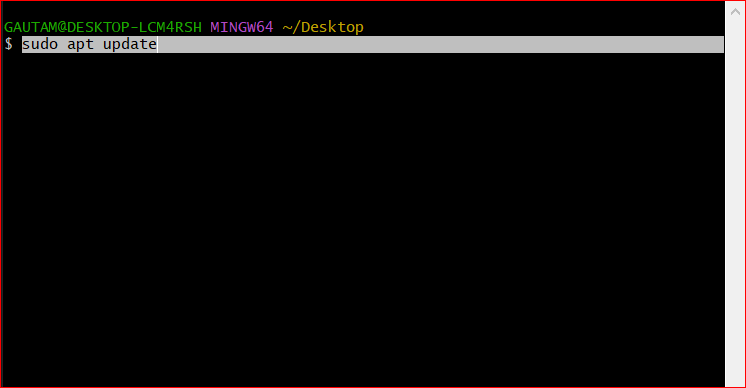How to Install Python-USPP on Linux?
Last Updated :
13 Jun, 2023
Python-USPP is a multi-platform Python library that allows communication between Python programs and USPP devices. This library is written in Python itself. It supports Windows, Linux, and MacOS. In this article, we will learn how to install this library in the Linux operating system.
Python USPP installation on Linux
The python uspp has been developed by ibarona, to access serial ports of uspp. There can be two ways by which we can install Pythondetail uspp on our Linux system. The first method is to use pip, and the second method is by cloning repo on GitHubPython, by ibarona. The following methods have been explained in detail below:
Method 1: Using pip
To install the python-uspp library using pip you need to follow the steps mentioned below:
Note: This method might not work in most of the new versions of linux because the USPP module was tested on Windows XP, Vista, and linux older versions. But you can try if method one does not work then go with the second method.
Step 1: Open the Terminal & Update Packages list. To do so you can navigate to the applications menu and select Terminal. We can also use the shortcut key Ctrl+ Alt+ T to open a new terminal. Then, write the command mentioned below.
Command: sudo apt update

Step 2: Use pip to install the USPP library to do so. Type pip install python-uspp, and press Enter.
Command: pip install python-uspp

Note: You may be asked to enter the password if you are not logged in as root. Enter password when prompted.
Step 3: python-uspp has been successfully installed, to verify the installation, run Python in your terminal by typing python or python3 this will open Python interactive shell and ensure no errors occur. After installing, our next step is to import the library, type import uspp to import the library we just installed. If no error message appears, then the installation was successful.
Command: import uspp

Method 2: Cloning Python-USPP Git Reop
Step 1: Go to the python-uspp git repository, by typing ibarona/uspp in search-box, in GitHub. Now, copy the source URL and use git clone "URL" command, to download the Source Code from the python-uspp GitHub repository.
Command: git clone https://github.com/ibarona/uspp

Step 2: To verify the installation, run Python in your terminal by typing python or python3 this will open Python interactive shell and ensure no errors occur.
Command: python

Step 3: We have successfully installed python-uspp in our Linux system. Now, our next task is to import the uspp. Use the below command to import uspp. If no error message appears, then, the import was successful.
Command: from uspp import *

Similar Reads
Non-linear Components In electrical circuits, Non-linear Components are electronic devices that need an external power source to operate actively. Non-Linear Components are those that are changed with respect to the voltage and current. Elements that do not follow ohm's law are called Non-linear Components. Non-linear Co
11 min read
Spring Boot Tutorial Spring Boot is a Java framework that makes it easier to create and run Java applications. It simplifies the configuration and setup process, allowing developers to focus more on writing code for their applications. This Spring Boot Tutorial is a comprehensive guide that covers both basic and advance
10 min read
Class Diagram | Unified Modeling Language (UML) A UML class diagram is a visual tool that represents the structure of a system by showing its classes, attributes, methods, and the relationships between them. It helps everyone involved in a project—like developers and designers—understand how the system is organized and how its components interact
12 min read
Python Variables In Python, variables are used to store data that can be referenced and manipulated during program execution. A variable is essentially a name that is assigned to a value. Unlike many other programming languages, Python variables do not require explicit declaration of type. The type of the variable i
6 min read
Spring Boot Interview Questions and Answers Spring Boot is a Java-based framework used to develop stand-alone, production-ready applications with minimal configuration. Introduced by Pivotal in 2014, it simplifies the development of Spring applications by offering embedded servers, auto-configuration, and fast startup. Many top companies, inc
15+ min read
Backpropagation in Neural Network Back Propagation is also known as "Backward Propagation of Errors" is a method used to train neural network . Its goal is to reduce the difference between the model’s predicted output and the actual output by adjusting the weights and biases in the network.It works iteratively to adjust weights and
9 min read
Polymorphism in Java Polymorphism in Java is one of the core concepts in object-oriented programming (OOP) that allows objects to behave differently based on their specific class type. The word polymorphism means having many forms, and it comes from the Greek words poly (many) and morph (forms), this means one entity ca
7 min read
CTE in SQL In SQL, a Common Table Expression (CTE) is an essential tool for simplifying complex queries and making them more readable. By defining temporary result sets that can be referenced multiple times, a CTE in SQL allows developers to break down complicated logic into manageable parts. CTEs help with hi
6 min read
What is an Operating System? An Operating System is a System software that manages all the resources of the computing device. Acts as an interface between the software and different parts of the computer or the computer hardware. Manages the overall resources and operations of the computer. Controls and monitors the execution o
9 min read
3-Phase Inverter An inverter is a fundamental electrical device designed primarily for the conversion of direct current into alternating current . This versatile device , also known as a variable frequency drive , plays a vital role in a wide range of applications , including variable frequency drives and high power
13 min read